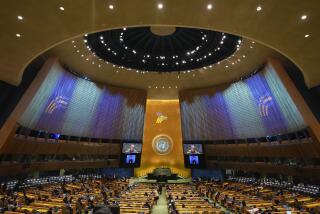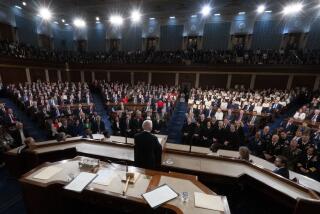Central America’s Wish List for New Deal
MANAGUA — The Reagan Administration has argued for six years that Nicaragua is the main threat to peace in Central America and, furthermore, cannot be trusted to negotiate. The region’s presidents broke with this dead-end ideology when they joined forces in Guatemala to sign a regional peace plan last month.
President Reagan’s “doctrine” has failed in every way. It has failed to promote President Jose Napoleon Duarte’s El Salvador as the regional model for democracy, just as it has failed to overthrow the Sandinista government. It has isolated the United States even among its own major allies in Europe. It has unified Latin America and has polarized the United States. If it has succeeded in anything, it is in revealing the total dichotomy between its ideology and reality. When even the United States’ best friends in Central America signed the Guatemala accords, it demonstrated that Washington, not Managua, is the main obstacle to a stable peace.
With the door to peaceful coexistence now opened, is it not the moment for the giant to the north to show that it is big enough to reach its own settlement with Nicaragua? In the real, not ideologized, world, there are bases for negotiation.
The United States cannot be expected to abandon its genuine security concerns in the region. Nicaragua, in turn, requires guarantees of its own national security. The other Central American countries, in whose name the United States has unleashed its multifaceted war against Nicaragua, have agreed not to permit the contras to operate from their territory and to exhort the United States to terminate its assistance to them. The United States, minimally, would have to agree with the Central Americans that this as “an indispensable element for achieving a stable and lasting peace in the region.” Nicaragua has already agreed in the Guatemala accords not to provide logistical or military support to insurrectionary forces in the region.
Another concern expressed by Nicaragua and the United States is that of foreign military presence in the region. Nicaragua’s willingness to forbid both advisers and bases has been on record since 1983. The United States would reciprocally have to abandon its military buildup in Honduras.
This leaves for discussion the reparations to Nicaragua ordered by the World Court.
These basic elements would show consonance with the new will of Central America’s and Latin America’s leaders. A more visionary president than Ronald Reagan could go further, seizing this moment to mold a new, mutually rewarding relationship with Central America that might serve as a model for relations with the rest of the Third World. What would such a new relationship require?
- Recognition that neither containment nor roll-back has succeeded in guaranteeing U.S. interests in Central America, nor will it in other Third World countries. The struggle for national self-determination is a fact of contemporary world politics. If the United States continues refusing to acknowledge legitimate North-South issues, it will confront ever more strife and revolt. Nicaragua does not profess to be the only model, but it is a novel and worthy one, which offers constructive coexistence with the United States.
- Recognition of a pluralist Central America. The Guatemala accords are tacit acknowledgement of Nicaragua’s principle of nonalignment, rendering stable and respectful coexistence with that country not only possible but also desirable.
- Recognition that the military conflicts in the region are a symptom, and cannot be cured with more militarism. The region needs profound changes just to achieve minimal justice, satisfaction of basic needs and political autonomy. Without these there can be no real peace, development, democracy or security.
- Recognition that a “new deal” for Central America has decided advantages for the United States. If even part of the $10 billion that the Reagan Administration has spent directly and indirectly in subsidizing the Central American convulsion were redirected to its reconstruction, the United States would be freed of a major financial burden and assured of growing markets, and, if such military shifts were extended, could begin to address its own economic crisis. The United States can no longer afford to mold the world in its image by force.
Is this a utopian dream? With Ronald Reagan in power, perhaps. The Administration has been busy behind the scenes trying to scuttle the Guatemala accords, as it has every Latin peace initiative of the last five years. But Reagan will soon be gone, and, barring the unpredictable, he will be the last of his breed. Already, from the ashes of Reagan’s dogmatism a new politics is emerging--one marked by flexibility, pragmatism and multipolarity. This can be seen in the Guatemala accords and the Contadora proposals, in the Rainbow Coalition and in churches and trade unions, even in Congress. All that remains is for a U.S. presidential candidate to articulate this change with a genuinely respectful policy alternative for Central America.
How will the United States greet the 500th anniversary of an encounter between two worlds? With only partial success, Spain and England imposed their cultures in this hemisphere; for more than a century the United States has sought to do the same in Latin America. By 1992 may we not aspire to a new, dignified encounter of equal but different cultures?
More to Read
Sign up for Essential California
The most important California stories and recommendations in your inbox every morning.
You may occasionally receive promotional content from the Los Angeles Times.










